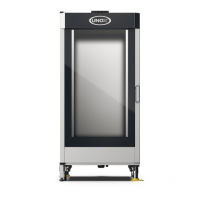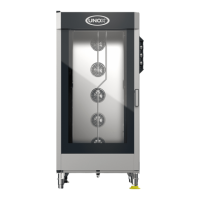PROBLEM SOLVING GUIDE
Check the following point if:
Symptom Problem Solution
The oven does
not turn on
F1 fuse of the pow-
er board blown
Replace the fuse, 160 mA fast acting. If the problem persists replace the
power board
The oven does
not turn on
F2 fuse of the pow-
er board blown
The oven does
not turn on
Power board dam-
aged
Measure on P9 socket between the blue and brown wires with the
voltage with the multimeter set to VAC. If the power board does not
supply 12 VDC to the control panel replace the power board.
The ground fault
circuit interrupt-
er (GFCI) trig-
gered
When you turn on
the power supply
the GFCI triggers
immediately
The transformer has an electrical leakage, therefore replace the power
board.
The ground fault
circuit interrupt-
er (GFCI) trig-
gered
When the control
board reboots
the GFCI triggers
The back-cooling fan supplied at 230 V AC has an electrical leakage,
therefore replace the back-cooling fan
The ground fault
circuit interrupt-
er (GFCI) trig-
gered
When the oven is
running a cooking
program the GFCI
triggers
Proceed as follow:
Set a cooking program, t = inf, T = 30 °C, v = 2 and run the oven.
• If the GFCI triggers, it means that at least one motor has an elec-
trical leakage. Test between the black and red wires of the motor
socket and the body of the oven with the multimeter set to ohm. If
there is a ground fault, replace the damaged motor.
If the GFCI does not trigger set T = 260 °C and run the oven.
• If the GFCI triggers it means that at least one heating element has
an electrical leakage. Test between the cable harnesses of each
heating element connector and ground with the insu-lation
resistance tester, if there is a ground fault, replace the damaged
heating element;
If you run the oven at T = 260 °C GFCI does not trigger, set STEAM.Plus to
100 % and run the oven.
• If the GFCI triggers, it means that the steam solenoid valve has an
electrical leakage. Test between the cable harnesses of the sole-
noid valve and ground with the multimeter set to ohm. If there is a
ground fault, replace the damaged solenoid valve.
When the control
board reboots the
circuit breaker trig-
gers
The back-cooling fan supplied at 230 V AC is shorted. Replace back-
cooling fan
Disconnect the low voltage loads sockets: P9, P10, P11, P12, P13 and P14
and replace the fuse (2A – 250 V Time Delay), connect the above
sockets one by one until you find the shorted component, therefore
replace it. If the fuse continues to blow replace the power board.
The circuit
breaker
triggered
